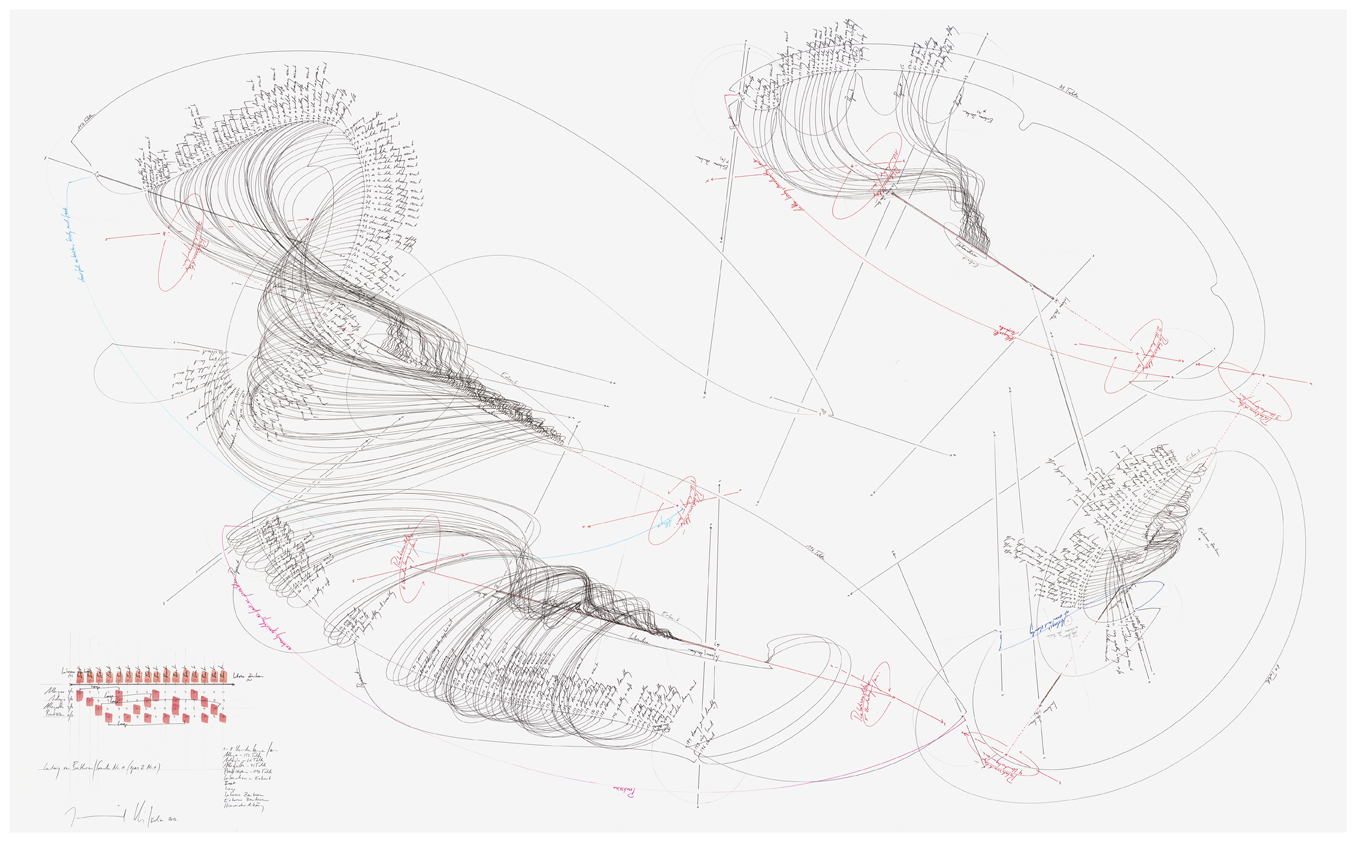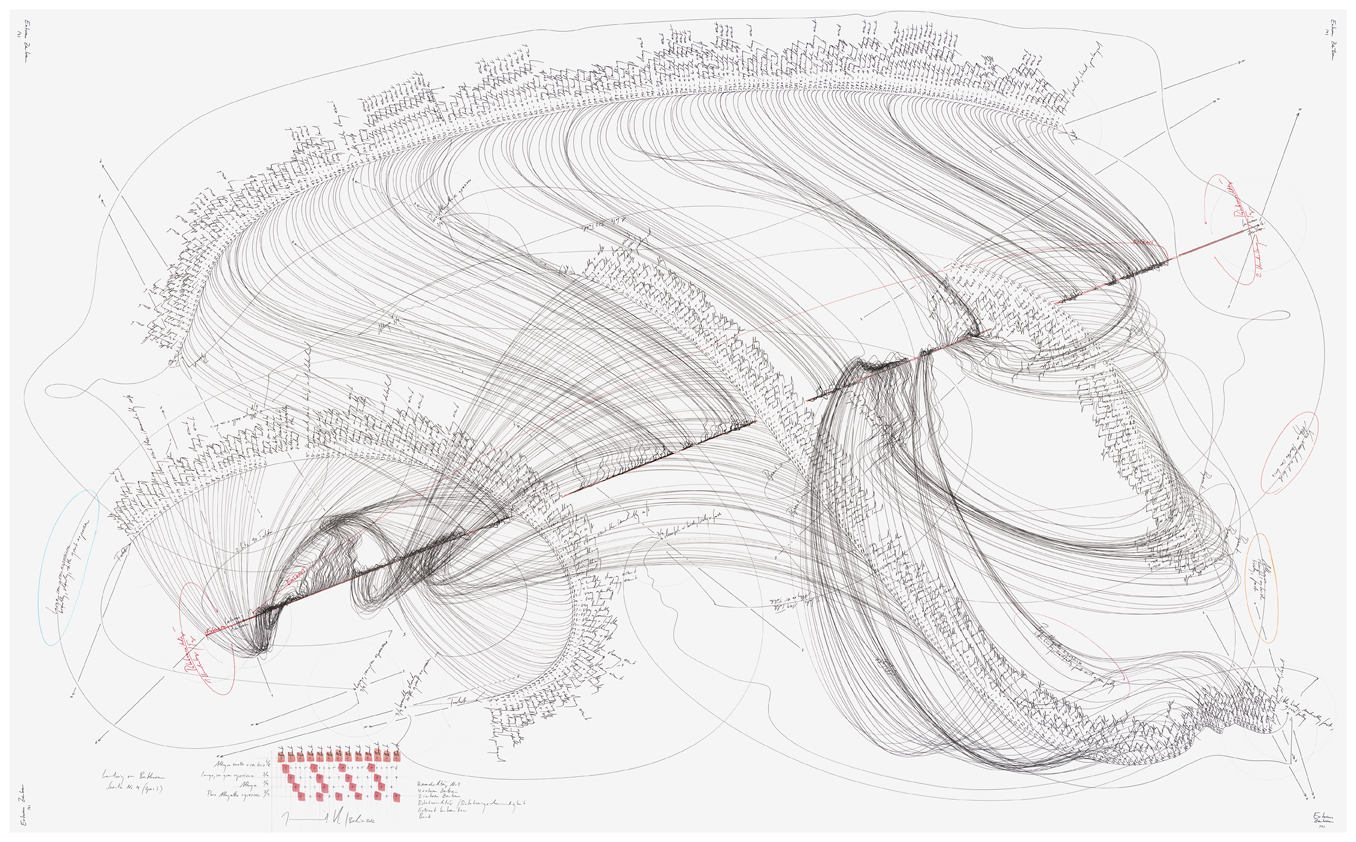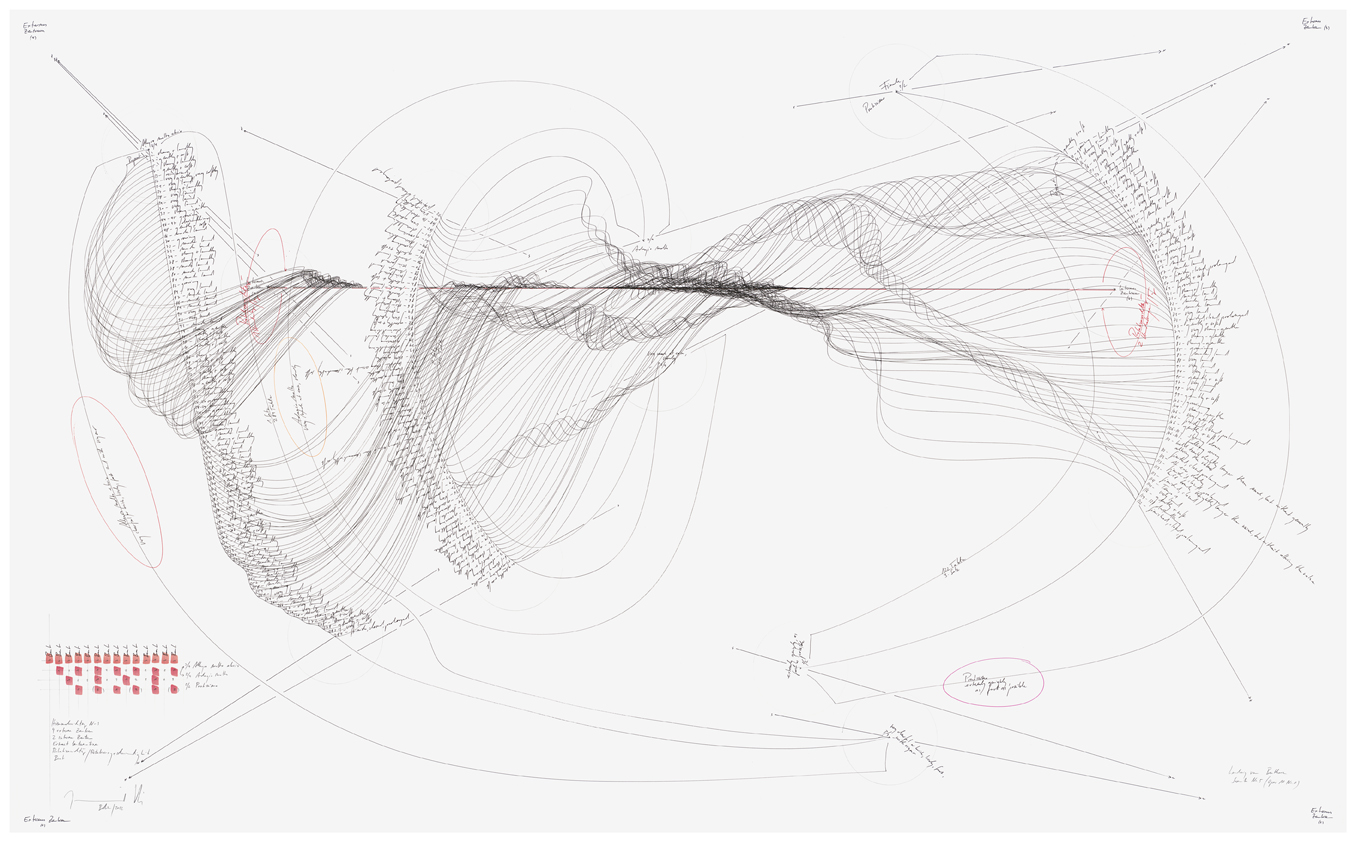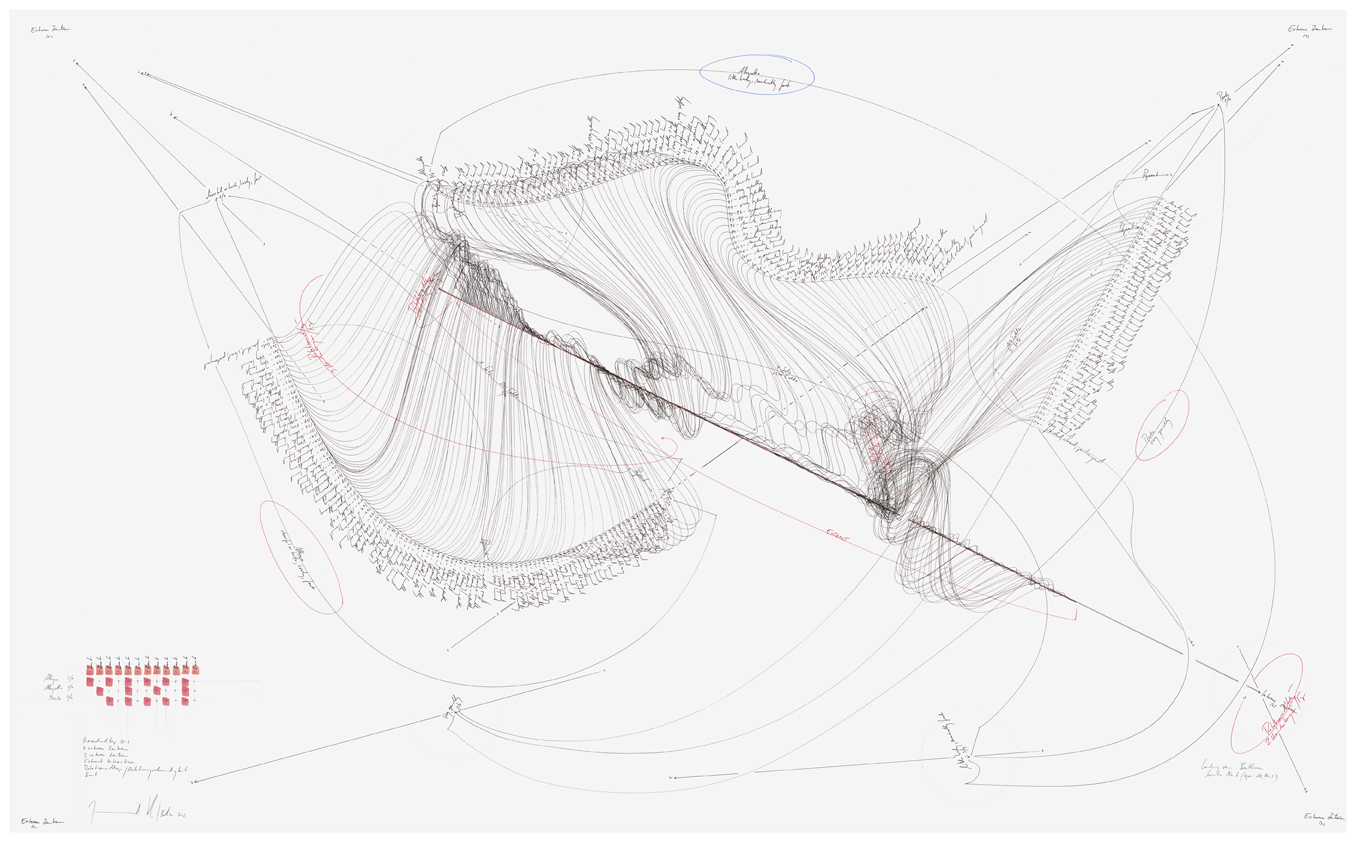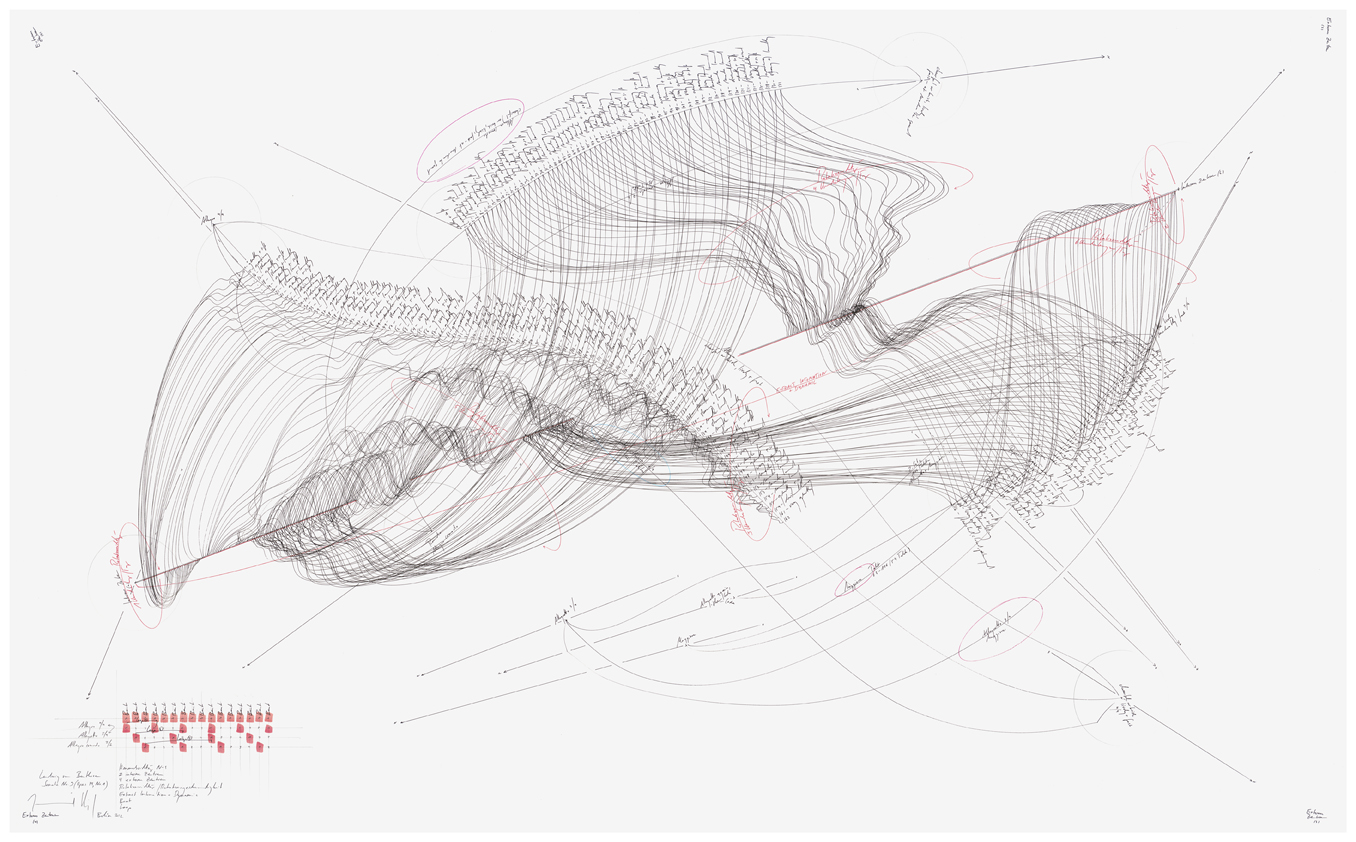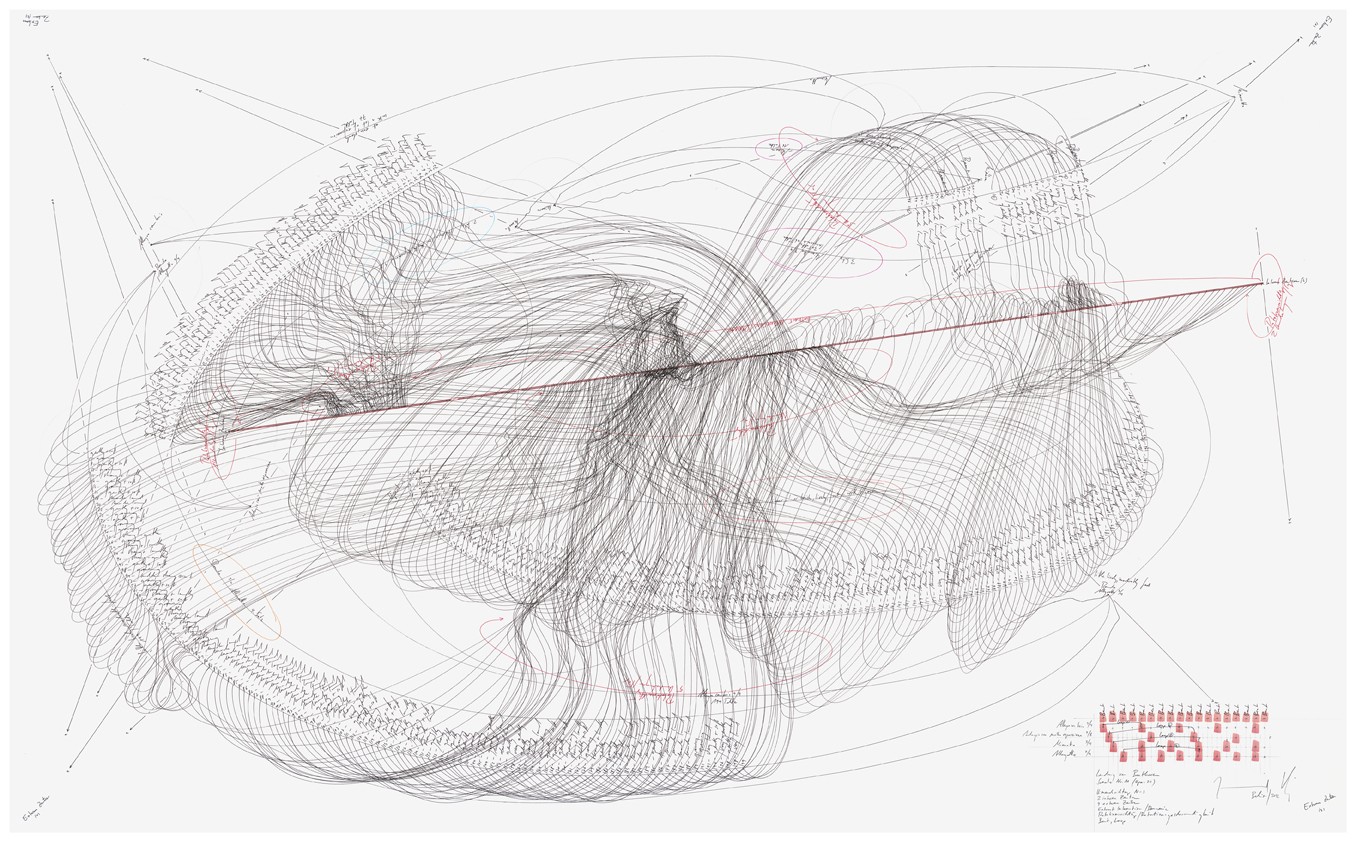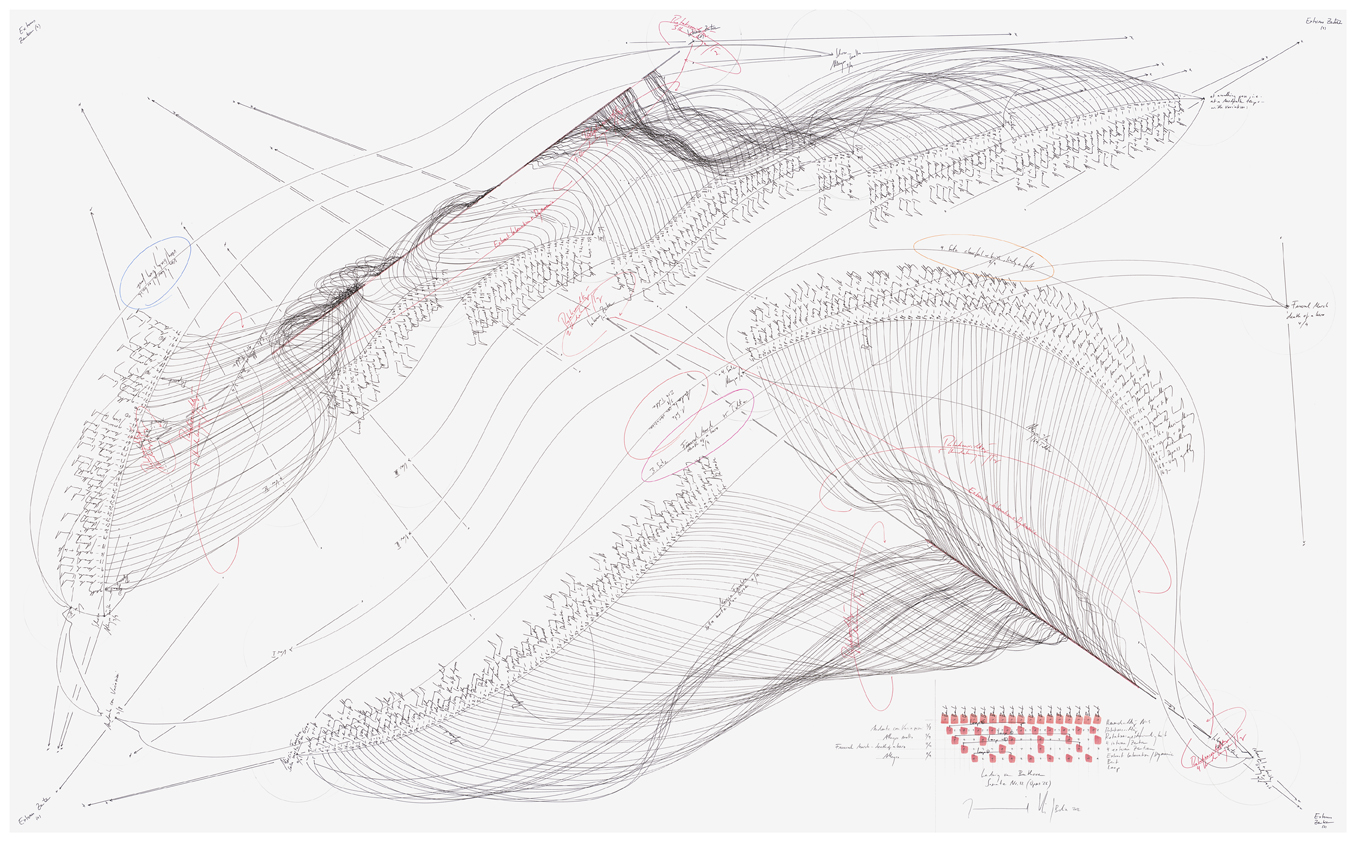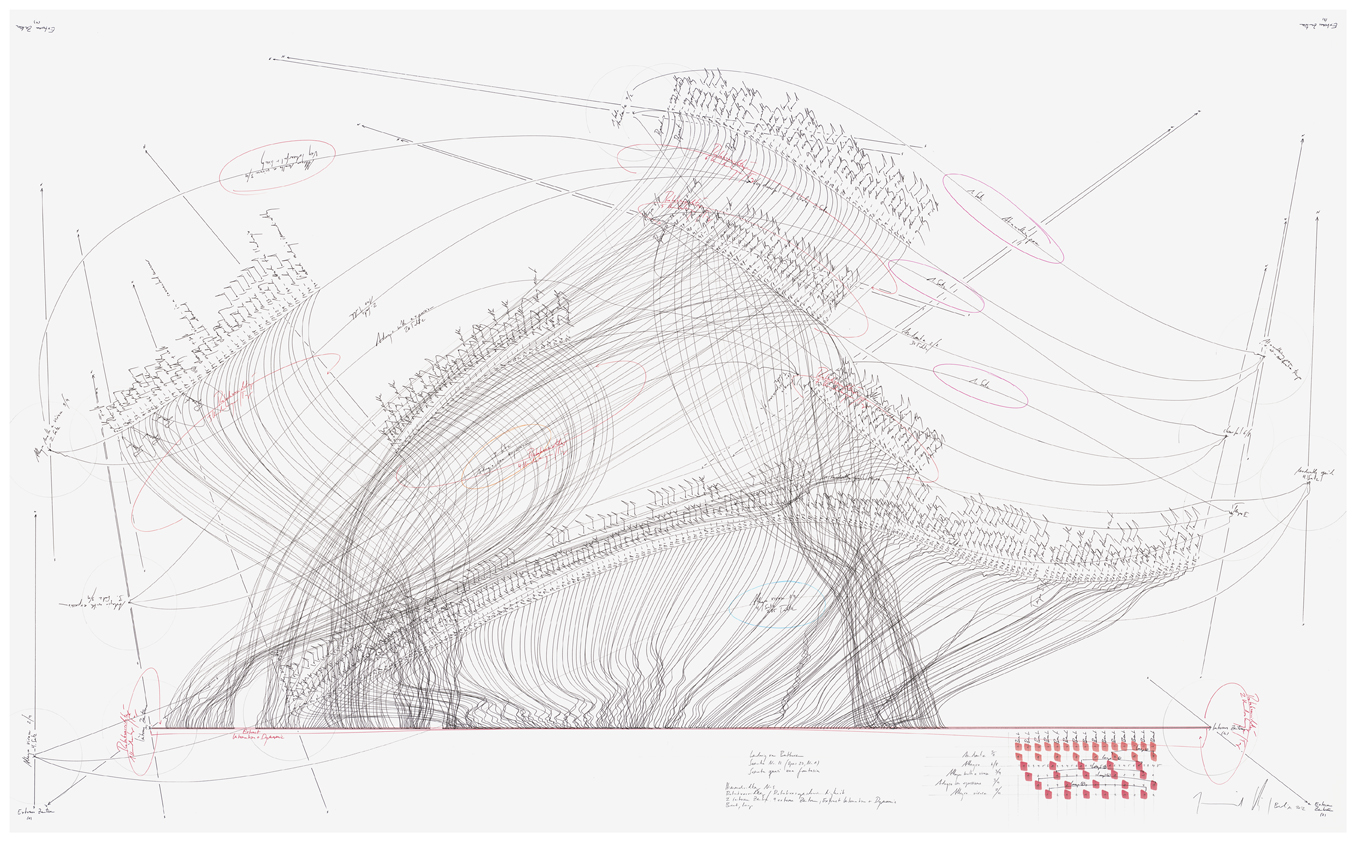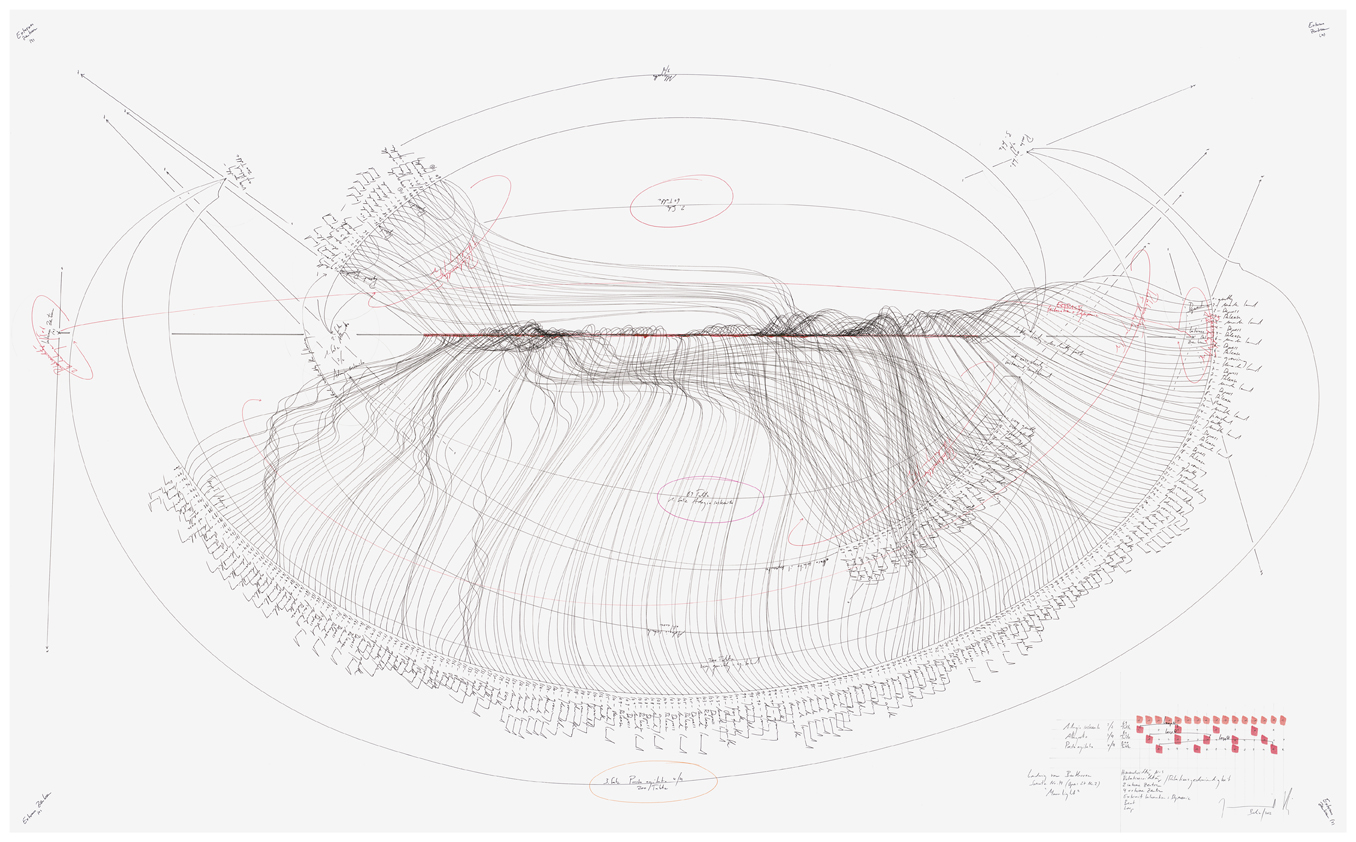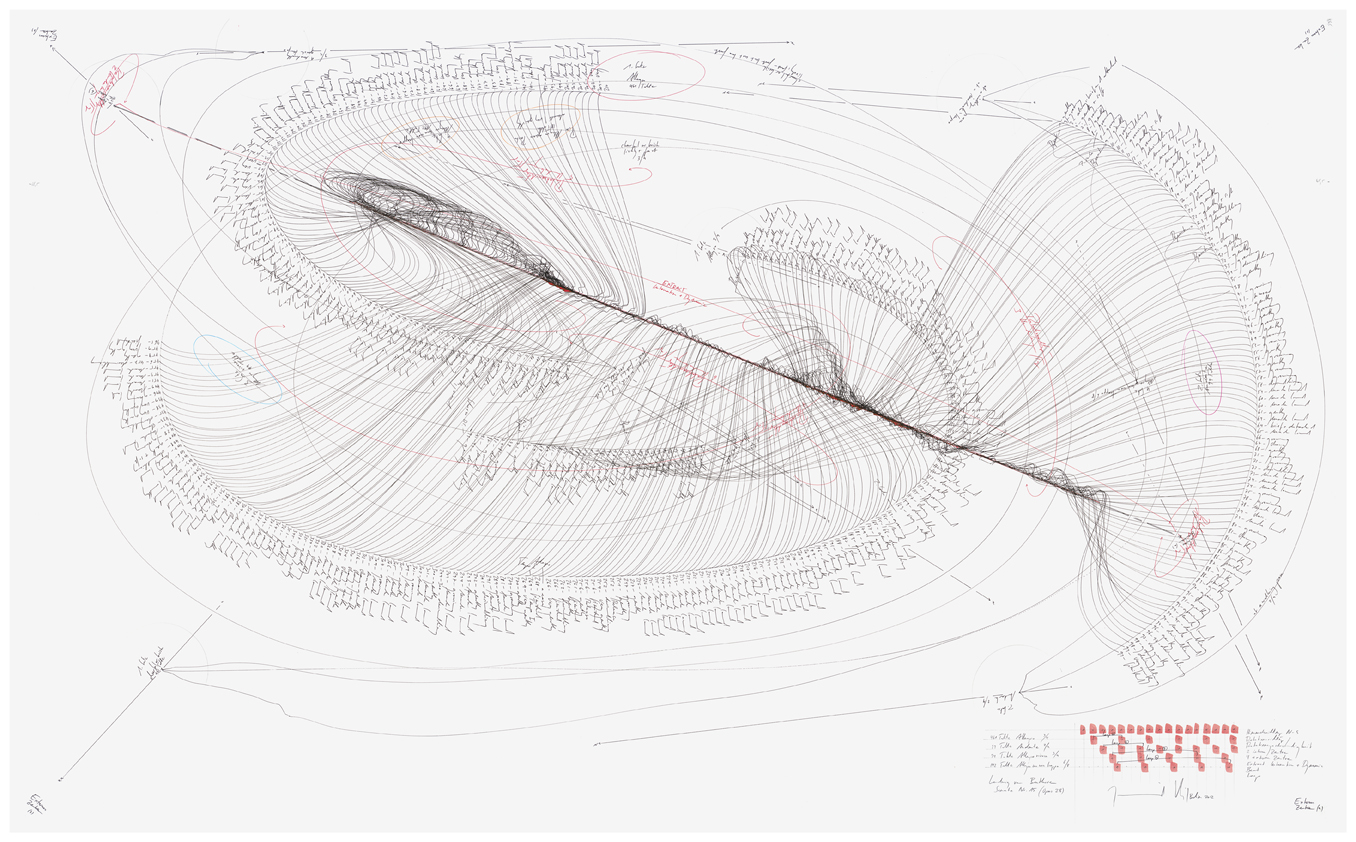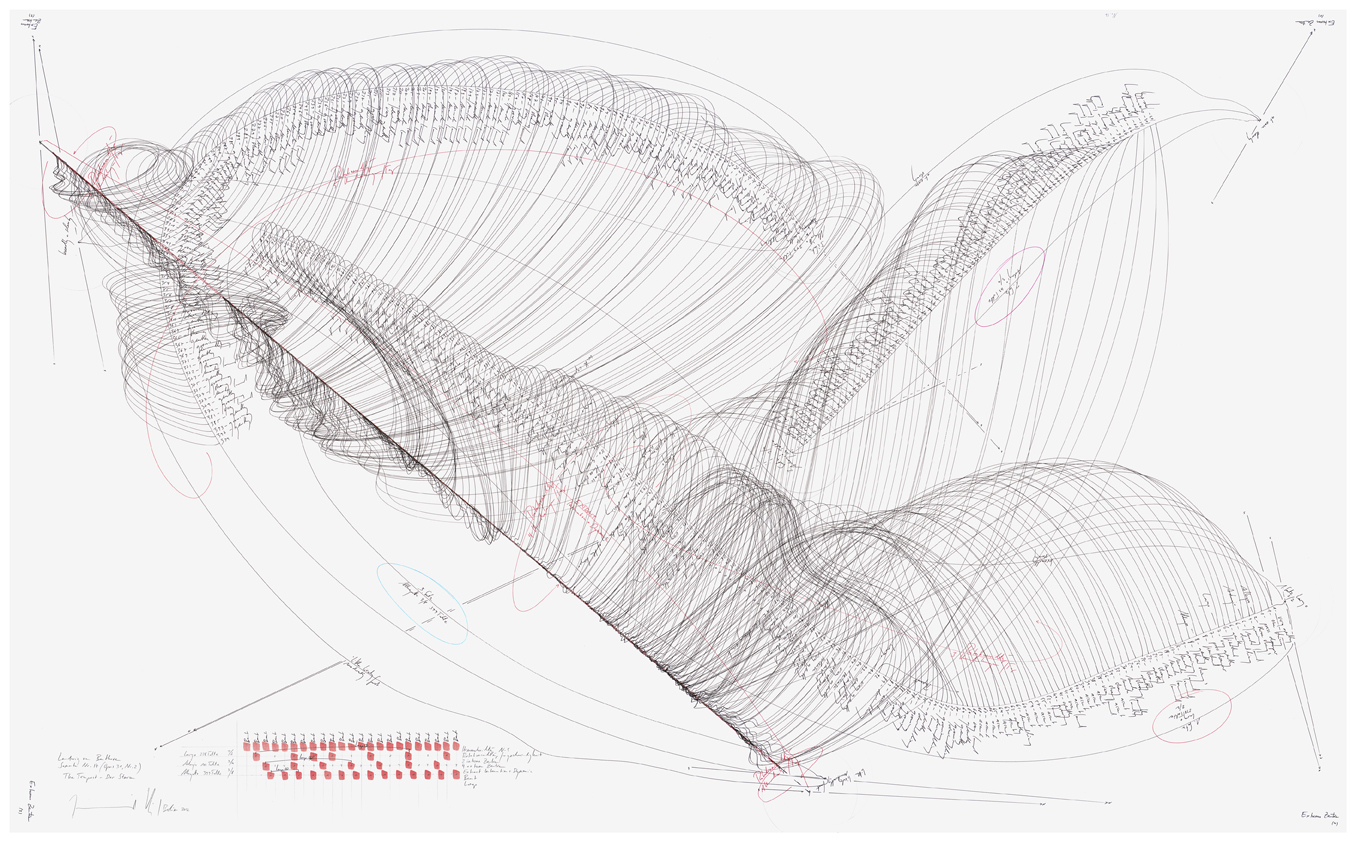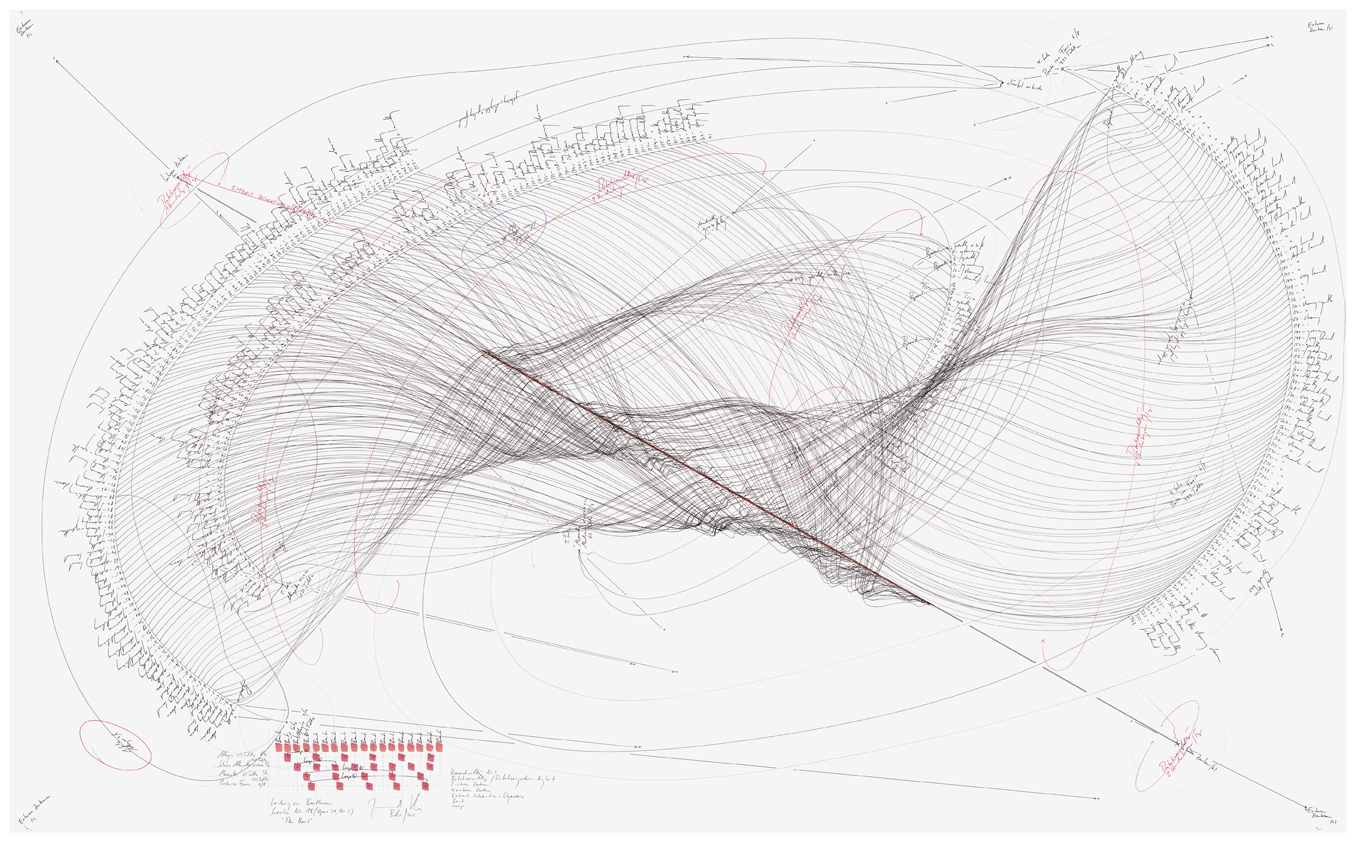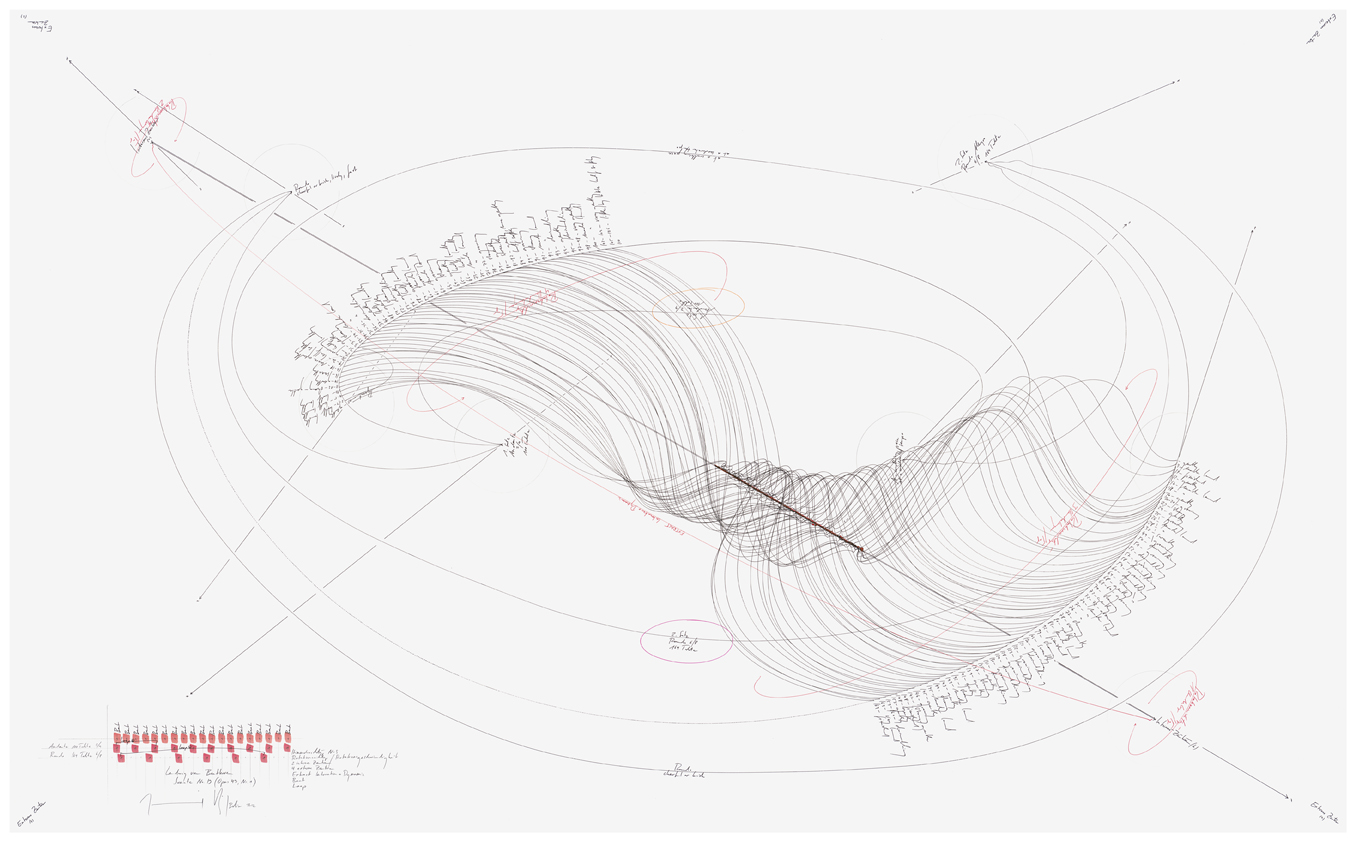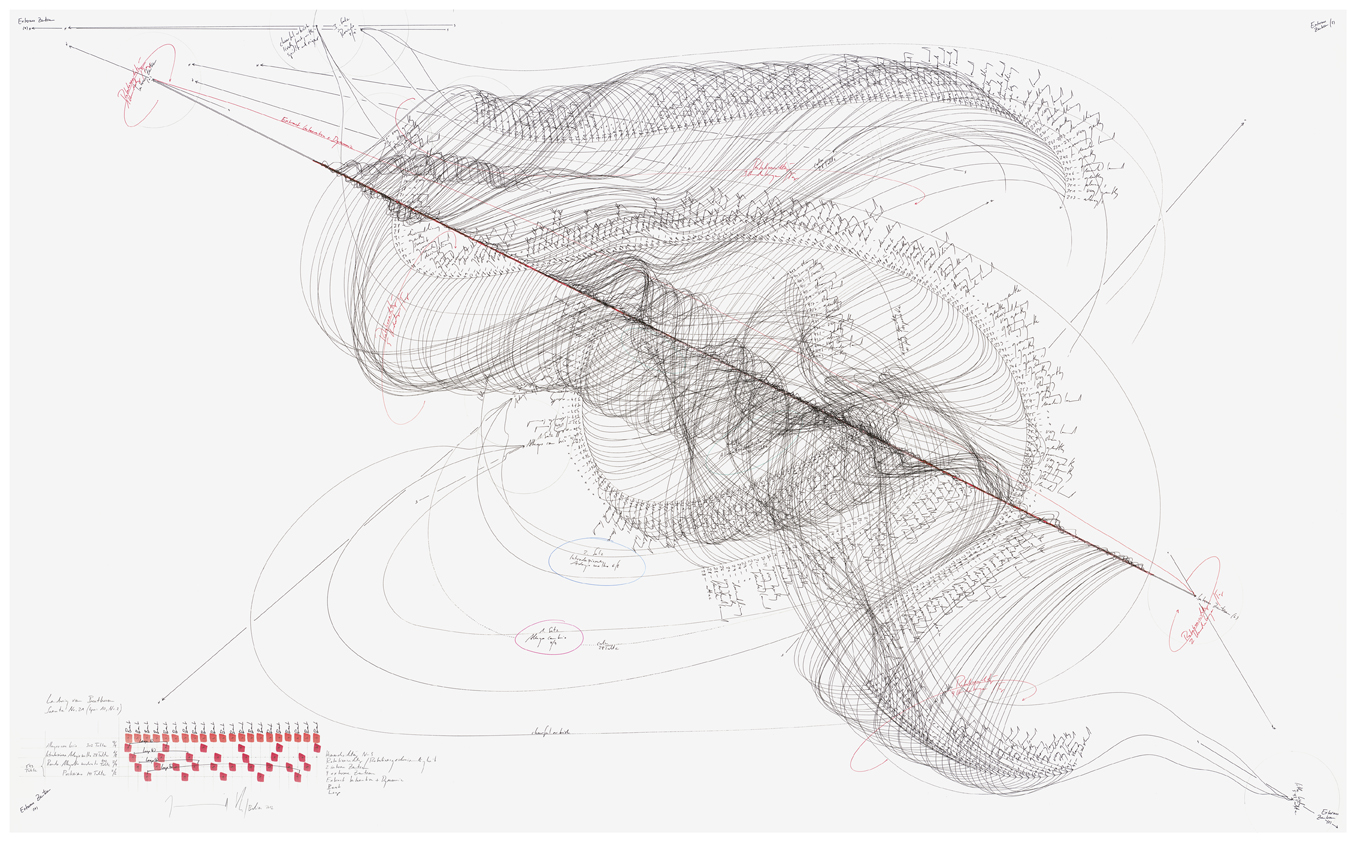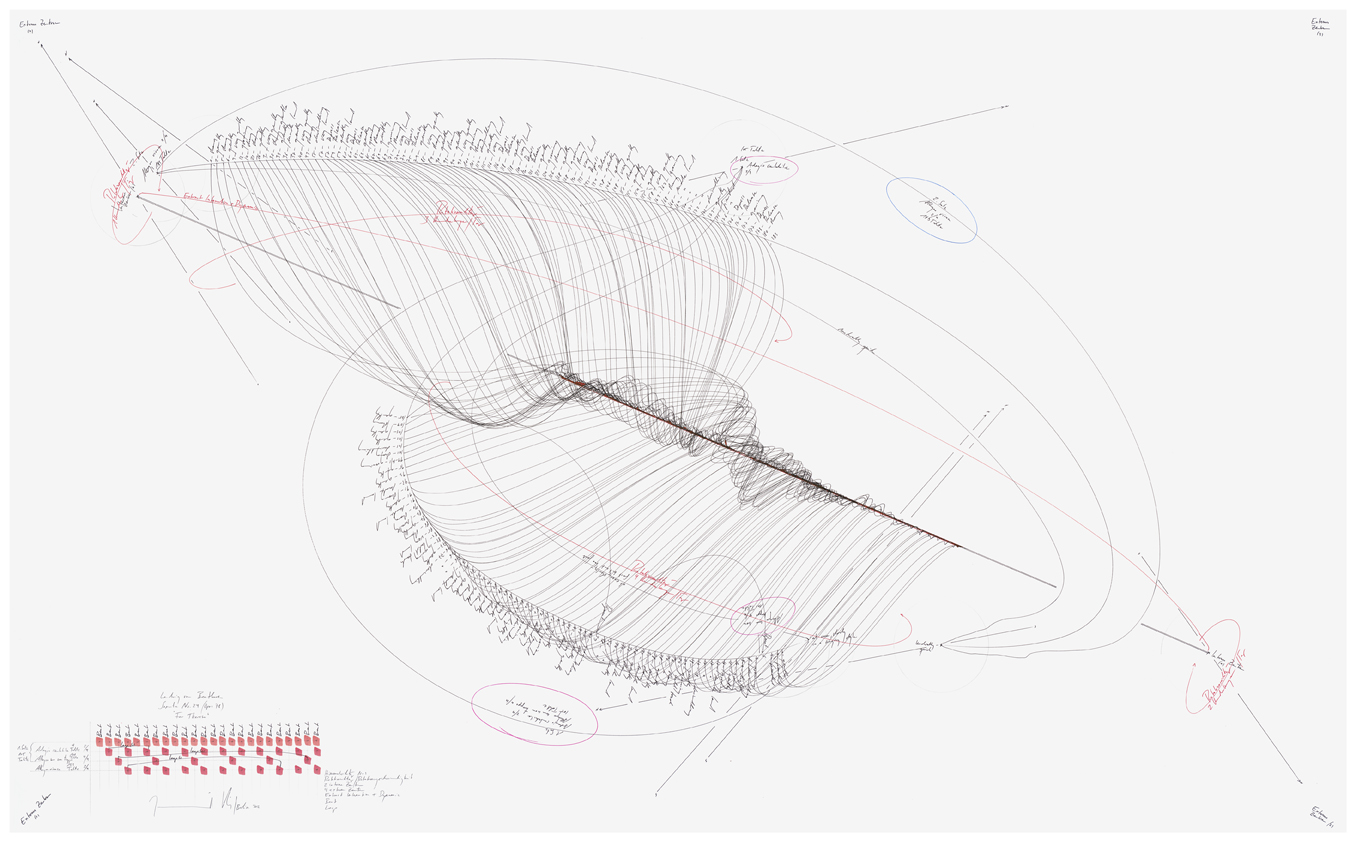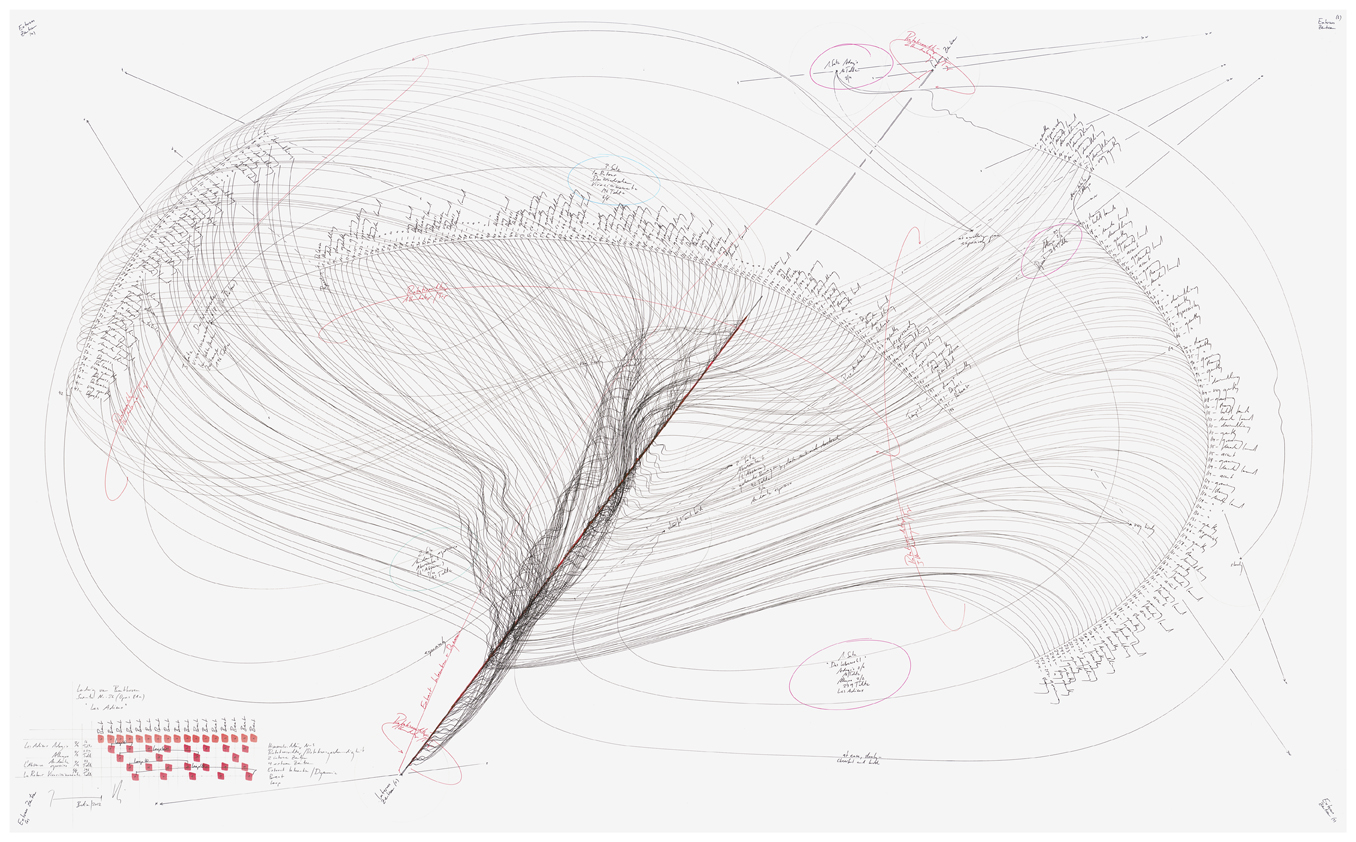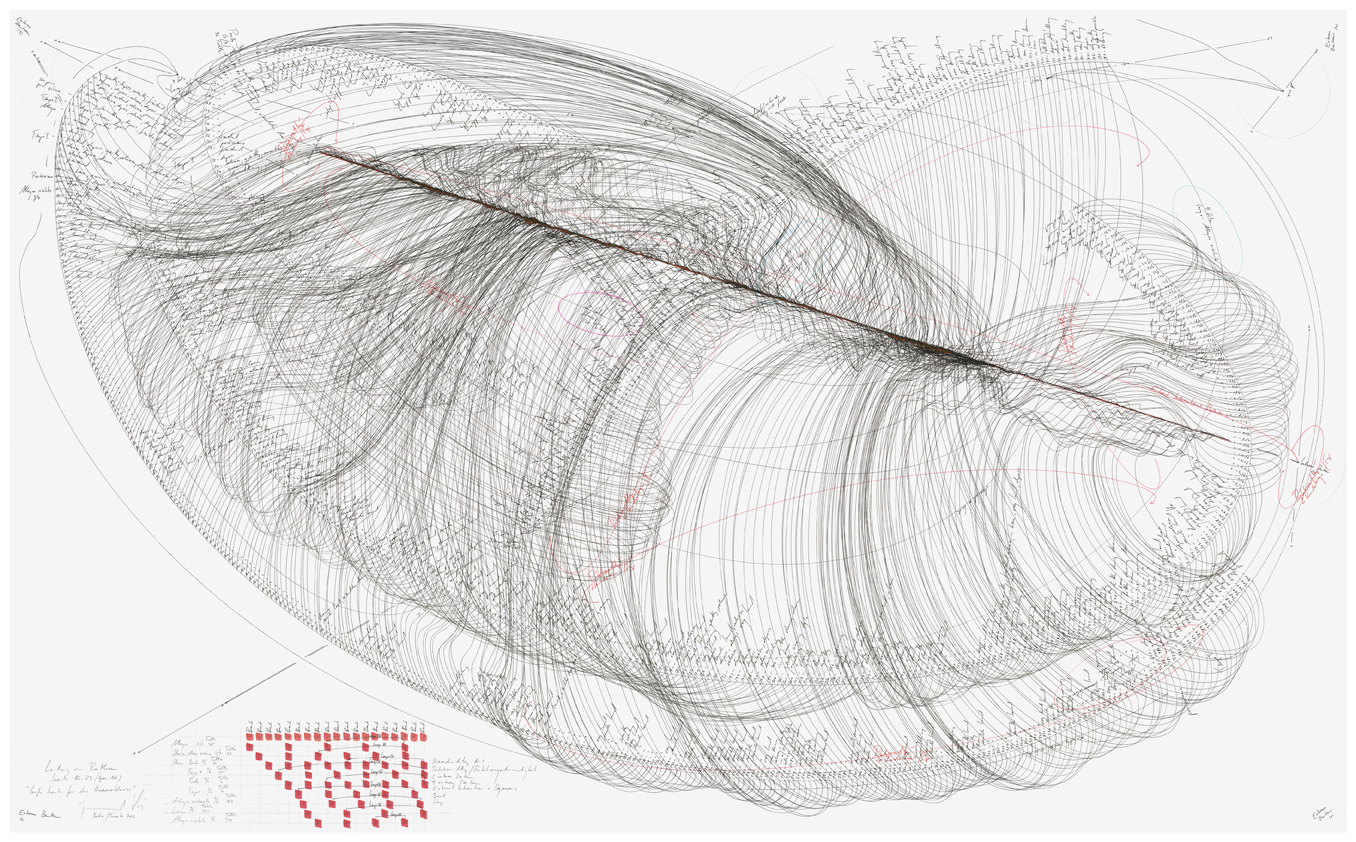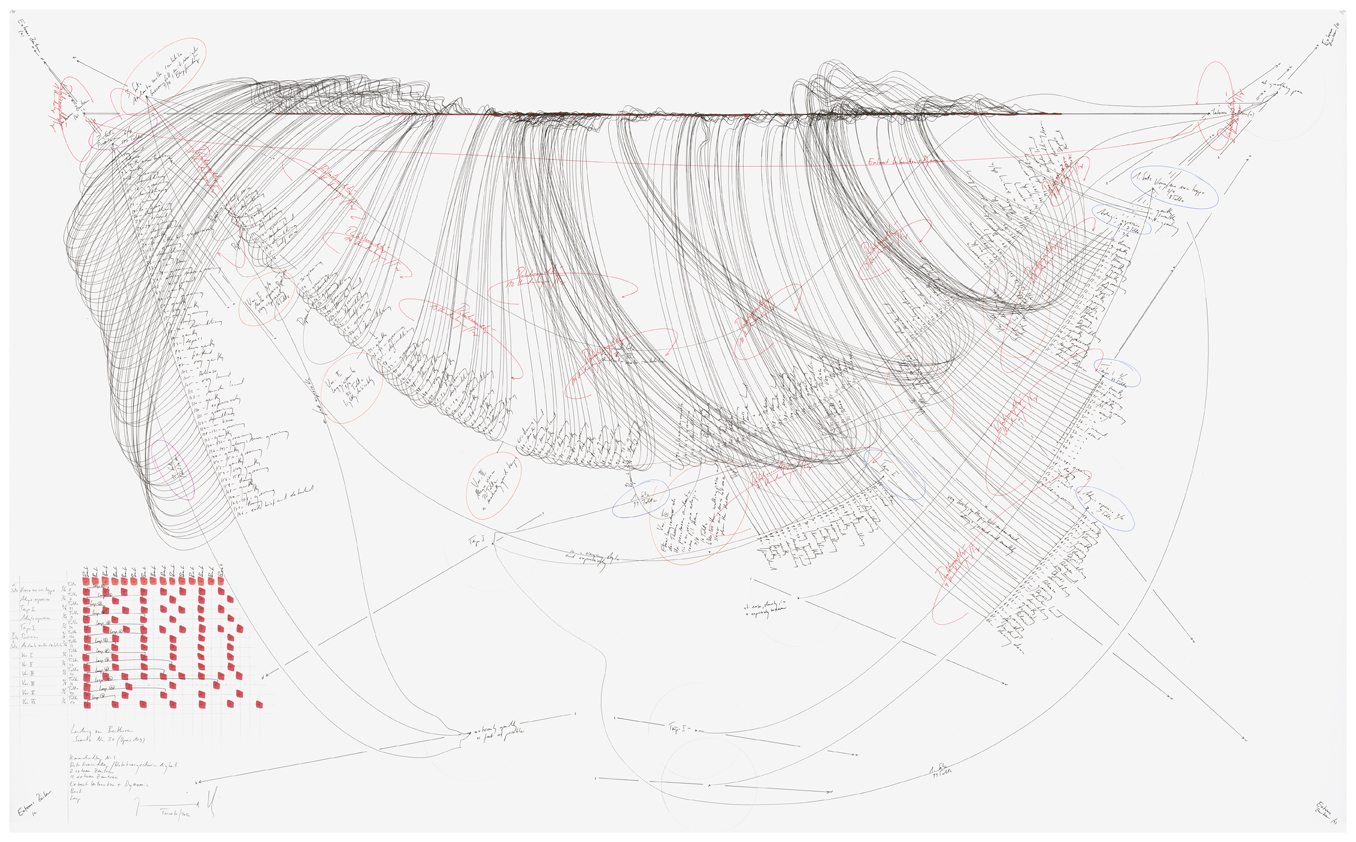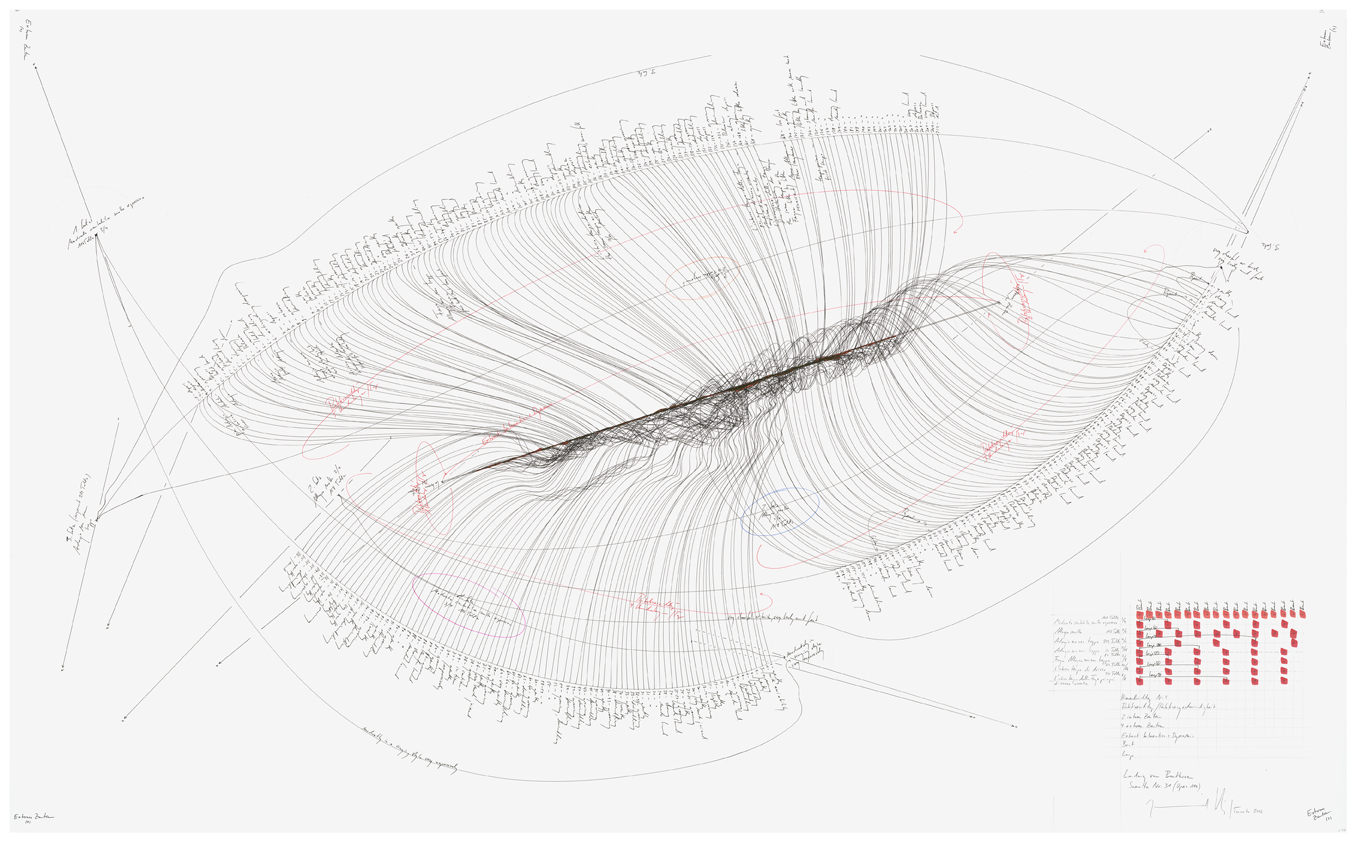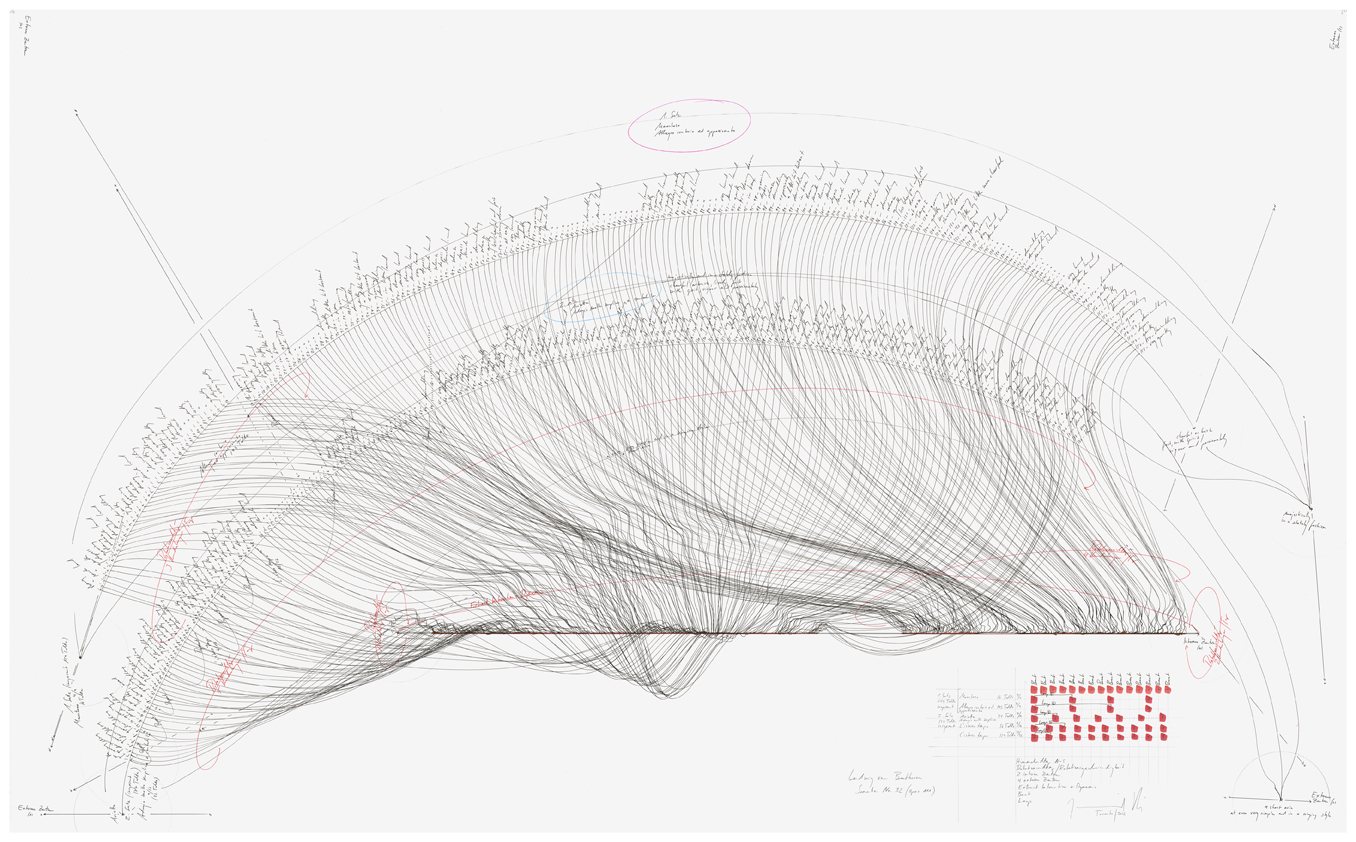Ludwig van Beethoven, Sonate 1-32
Text by Jorinde Voigt, 2012
The thirty-two part work Ludwig van Beethoven Sonata 1–32 developed from the following consideration: How might it be possible to reflect Ludwig van Beethoven’s music on a universal level without a new notation becoming an illustration or merely a pure interpretation of the music?The greatest challenge for me was to develop a notation that would “extract” the extremely emotional spectrum that is embedded in a Beethoven composition. This “extraction” occurred along the structure of the urtext score, which transports and communicates the experience of music.
Extract Interpretation + DynamicsI began with writing out the indications of interpretation and dynamics (notations for tempo, relative loudness or softness; instructions referring to style, manner, or modus) from the urtext1 of each piano sonata bar by bar, movement by movement, and sonata by sonata. I then translated Beethoven’s original Italian and German notations into English in order to position the themes of emotion, interpretation, and dynamics from the context of the music on a level on which it can be communicated internationally and that relates to a universal area of experience. These extracted progressions form the basic framework in my work.2 Beethoven’s progressions are unique and rich in variations. They are com parable in a certain respect with the emotional “trail” that results from experiences and actions over the course of a day, a season, a year, or a life. (The succession of emotions that is experienced during a particular event, when concentrating on a specific subject, or over a particular period of time engender, along with the personal attitude toward and varying speed of one’s own agitation and condition, an organic, unique, meandering line; a specific, irreproducible pattern resembling an inevitable trail of universal experience.) As a composer, Beethoven communicates an extreme range of emotions. By notating them on a time axis, his indications with respect to dynamics, attitude, character, and expression create a type of “trail” or chronicle of highly concentrated experience for me. The thirty-two piano sonatas were composed between 1795 and 1822, and as a result of them being written down at that time, the trail contained within them can be called up and reproduced at any time and is endlessly and timelessly contemporary for those who experience the music. The individual trail of the indications of interpretation and dynamics is listed on each sheet dedicated to a specific sonata, with time signatures along a line drawn freehand.3 I drew this line intuitively while listening to the corre -sponding part of the move ment of the sonata and attempted to depict the characteristics of the melody and progression of motifs summarized in one line as well as in relation to one another. Beethoven wrote between two and four movements for each sonata. Consequently, there are two to four such trails on each sheet of my notation—in part staggered if changes in tempo or other modes take place in the movement.Internal Centers and External CentersThe space in which the arrangement is situated is defined in each case by means of two to eight “internal centers”4 and two to four “external centers.”5 The concept of an internal center stands for an “inner compass” or “inherent states.” The internal centers are connected with one another by means of an axis.6 Each individual word and bar signature in the trail is connected with this axis by a spontaneously drawn line.7 The extract forms along the axis with its endpoints consisting of internal centers; a distillation of the emotional trails that are linked with them: their zero point. The connecting line between axis (and/or zero point) and word denotes the area between genesis and the ability to formulate how experience is communicated. The four “external centers,” which in their arrangement are similar to the four cardinal directions of the compass, denote any form of “external” force, pressure, action, or external conditions or circumstances that are situated opposite the “internal centers.” The term “external center” represents any possible external point of reference, whether geographical, social, ideological, political, cultural, economic, et cetera. The content-related axis between internal and external centers is the space for negotiation and at the same time the possible scope of action between the two poles.
This is precisely where the unfolding of the relationship between the linear trails of the individual movements that is implied in every notation is situated, as is the finely graduated variation of emotions through time from the area of what can be communicated to what is unnamable, where everything is reduced to one point.Rotation Direction / Rotation VelocityThe axis of each notation is described as rotating continuously8 so that it develops something like a vortex from the axial rotation in which the entirety of the individual changes in the indications of interpretation and dynamics are reflected and pictured as an extract.9 The threads of the connecting lines that run between each word of one of the trails of the sonata and the axis are also subject to their own rotation.10 The specific rotation velocity (1–x rotations per minute, per day, or per hour) corresponds chronologically to the sequence of the notation and is interchangeable in the individual values.Compass Directions N–SThe points at which the trail of each movement—the emotional chronicle—begins and ends, but also the endpoints of the underlying line as well as the points at which the internal centers are situated, are each indicated by means of an arrow with a north-south designation.11 These arrows point to one or several of the four “external centers” and specify the geographical orientation and/or, in their entirety, changes in geographical orientation.Beat + LoopThe different time signatures of the individual movements are noted in red ink as synchronously elapsing trails of beats in the lower section of each drawing. They generate a pattern made up of two, three, or more synchronized beat sequences. Each sequence is the rhythmic extraction of the associated sonata movement. These beat sequences are also trails or “chronicles of rhythm.” Read musically, the framework of the synchronization of the rhythmic structures of a sonata generates a meta-rhythm by means of the resulting interference that is specific to each sonata. Loops12—represented by black lines that bracket the red squares of the beats—are inserted into the synchronized beat sequences. The loops consist of the particular number of beats in the rhythmic sequence and present them as areas designated as a “loop” on the level of eternally recurring, unchanging units of time. This structure is coexistent with the meta-rhythm as well as part of it. Just as a musical score (notation) develops an additional quality in the course of its being interpreted musically, the viewer of the drawings can allow the processes of rotation described to develop in his or her imagination and by doing so lend additional dynamics and dimensionality to the content of the drawing.
JORINDE VOIGT AND MUSIC−FOR EXAMPLE, BEETHOVEN SONATAS
Text by Franz W. Kaiser
When I first saw drawings by Jorinde Voigt some seven years ago, what immediately came to my mind were graphic musical scores by avant-garde composers such as Henri Pousseur, György Ligeti, Mauricio Kagel, or Iannis Xenakis. They all used unconventional symbols, often in combination with classical musical notation, for pitches outside of the chromatic scale, for flexible rhythm, for clusters, or to specify how the instrumentalist is to perform a piece. Yet the associations that promptly arise during initial encounters with the work of an artist are often deceptive: no instrumentalist would be able to play Voigt’s drawings from the sheet, since they do not designate any tones. Furthermore, the sheets would be too large for that. The drawings are thus determined by Voigt’s physical reach. She draws from all sides, sometimes even lying directly on the sheet, which contradicts the linear progression of music. Yet in this case it is possible to apply a reference to music, since it is the most physical of all art forms; and indeed, some graphic musical notations—for instance the score of Mauricio Kagel’s Zweimannorchester (Two-Man Orchestra)—even go so far as to specify the postures that the instrumentalist should assume.1 Jorinde Voigt listens to music when she draws. However, there is hardly any indication of her inner relationship to music in her official biography. From the ages of nine to nineteen, she received violoncello and piano lessons in Darmstadt—where the musical avant-garde of graphic musical notation began with the Darmstädter Schule (Darmstadt School)—and during this period she also con-sistently played in youth orchestras, from duos to quintets, and regularly took part in music competitions. Her youth, as she says, was spent “intensively in the world of music. . . . and [she] was quite good with the cello.”2 When she began university, she struck out on new paths—first studying philosophy and German literature, then sociology, and finally the fine arts. My initial association was, therefore, perhaps not that wrong. Because of these biographical influences, which by all means may have led to Jorinde Voigt becoming a musician, the frequent use of the term “notation” in connection with her work deserves special attention, since, historically speaking, notation developed as a specific system of symbols in music—a history that can be traced back to the Middle Ages. Notes are symbols for specifying tones in writing. The pitch is expressed by the progressive arrangement of notes on lines, the relative duration of the indivi-dual tones by the form of the note, the rhythmic grouping and the position of emphasis by time signature and bar lines; tempo, intensity of sound, ornamentation, articulation, as well as additional details are expressed by written addenda or specific symbols.3 Long before music came to be recorded on sound storage media such as records, audiocassette tapes, or compact discs and could be played back at will, transcribing it in writing allowed it to be preserved, since musicians are able to play from written notes quite accurately. Furthermore, as a structuring system of symbols, notations became the tool of composers, leading to a more conscious handling of the artistic means of music. Musical notation achieved its ultimate definition as an analytical composition tool—perhaps not coincidentally—in the seventeenth century, when the modern sciences were born and which was characterized by a general need for intellectual penetration. Interestingly, notational systems have hardly played a role in the history of the visual arts. This is where a significant difference between these and other art forms such as music and literature is situated, a difference that the American philosopher Nelson Goodman identified as early as the sixties:4 the consummated work of art that is intended for the audience is not the score or the manuscript but rather the respective performance and/or printed edition of the book. Scores or manuscripts are of interest at most for musicologists and literary researchers, and when they achieve high prices at auctions, then this has more to do with fetishism than with their artistic value. In the visual arts, in contrast, everything revolves around the irreplaceable original. Even editions are meticulously signed and numbered and are thus derivations of the status of the original, since the market value of the respective copy is measured against the total number of copies that have been produced.
Graphic notations can be seen as transgressions of this boundary of essence on the part of music if they are graphic “in themselves” and aesthetically expressive. Boundaries have also been transgressed on the part of the visual arts. At exactly the same time Goodman published his thoughts, the American Minimal artist Sol LeWitt developed his ideas on Conceptual Art. In his reflections on the execution of his Wall Drawings, he deliberated on an allocation of roles between the artist and those who execute the drawings, and the systems of notation that he developed played a major part in this.5 According to LeWitt, the concept is the artist’s share. It is sum -ma rized in a verbal description, perhaps supplemented by a drawing, in a certificate, or simply only in the title—the more succinct the better, since all the more elegant. At the same time, the concept has to be precise enough for someone else to be able to execute it without the execution deviating significantly from the artist’s concept. The definitive work is therefore not the concept of the artist but rather the exe-cution of the Wall Drawing by others—and so it is no wonder that LeWitt was also a great music lover. Notations also play a major part in information technology, where they define mathematical rules of order—and the role of notation in the work of Jorinde Voigt initially has to be understood in analogy to this, since algorithms are at the root of many of her drawings. Algorithms are precisely defined instructions for the solution of a particular problem within a finite number of iterative steps. However, they can also generate infinite structures. These may be mathematical problems, thus as in information technology, or simple recipes such as “cooking an egg,” which Jorinde Voigt’s transformed into an artwork of the same name. The work 2 küssen sich / 2 People Kissing is also such an algorithm that can be traced back to a performance at the Contemporary Art Center in Vilnius in 2006, which then led to a series of fourteen drawings. The physically performative is thus another root of Jorinde Voigt’s drawings. Yet she has also devised algorithms that do not refer to concrete acts, such as Adler (Eagle), Popsong, Strom (Electricity), Temperaturverlauf (Temperature Curve), in order to use and repeatedly recombine them, as in the monumental, twenty-two-part work STAAT / Random (2008), which was presented in the Project Hall of the Gemeentemuseum Den Haag in 2010—an exhibition space that directly flanks the permanent installation of Sol LeWitt’s Wall Drawing #373. If for LeWitt the “idea becomes the machine that makes art,”6 Jorinde Voigt’s works are generated by algorithmic rules that are implemented by means of matrixes. In contrast to LeWitt’s concepts or to classical musical notations, which have to be precise and unambiguous so that they can be executed accurately, Voigt’s algorithms permit a certain degree of openness, which implies a measure of unpredictability—hence the use of the term Random in the title. Voigt then also has to execute her drawings herself. The generative rules, based on which lines, words, numbers, arrows, and so forth are combined with one another, can, when applied stringently and despite all their detailed precision, generate extremely complex clusters, which as superstructures are in turn capable of addressing emotions. I can imagine that one might be able to distill quite similar structures from Wassily Kandinsky’s abstract improvisations, and indeed all the more, since it was possible to see some of them at the same time as Jorinde Voigt’s exhibition several rooms away at the Gemeentemuseum Den Haag—a happy coincidence.7 It is possible—not in the symbols or denotations of them, but rather in the way in which Voigt deals with them—to make out a clear analogy to the use of graphic notation in the case of composers such as Henri Pousseur, for instance in his Paraboles-mix from 1972, a “semi-improvised mixture (according a plan that is renewed for every performance) of the eight ‘Etudes paraboliques’ that were produced in 1972 and are distributed by three independent tape-recorders and a mixing-table for two to four groups of loudspeakers. . . . Paraboles-Mix thus appears to be the complex process of a voyage into a multidimensional universe of sound and imagination.”8 In this connection, it should be noted that music, as the first art form, made use of the possibilities of information technology in order to generate complex structures. We are far from the linear method of notation of Hanne Darboven, with whom Jorinde Voigt has at times been compared. Even some of the titles of Pousseur’s eight etudes—Les ailes d’Icare, Liebesduett, An Heinrich / Ping-Pong—recall her algorithms.
Bearing in mind Voigt’s intimate association and all these affinities and analogies to music, it was therefore obvious that she would dedicate herself, so to speak, frontally to this source of inspiration in her artistic work. And she has now done so quite plainly with her series on the thirty-two sonatas by Ludwig van Beethoven. The point of departure for these drawings is no longer one or multiple generative algorithms but rather the scores of the sonatas. What interested her, as she told me on the telephone, was exploring emotion and perception. Beethoven’s sonatas provided not much more than an occasion—it might also have been another composer—although as a composer of emotionally charged music Beethoven naturally seemed appropriate for this theme. What is now of particular interest for the viewer is whether and to what extent the emotionality of his music corresponds to that ofVoigt’s drawings. Kandinsky was interested in a corres pondence between music and painting in quite a similar way, and his contact with Schönberg gave him a decisive boost in his breakthrough to abstract painting. Music is by nature an abstract art form. With respect to emotion ality, however, it is much more direct, much more concrete than visual art, which brought Kandinsky to the idea that abstract painting might address inner sensitivity much more directly than figurative painting. Correspondingly, Jorinde Voigt, as she presented in her concept text on the drawings to Beethoven’s sonatas, wanted above all to avoid these being illustrations or interpretations of the music. Scores are in themselves already abstractions of the music that they notate. Voigt added to this one further level of abstraction: from the scores, she extracted the notation for intonation and dynamics, that is, for musical expressions, such as “forte” (f), “piano” (p), “pianissimo” (pp), “crescendo” (cres), listed them in the sequence of the bars, and translated the values into English. While drawing, the lists served as a guide—quite like how the matrixes generated by means of algorithms did in the case of other drawings. They are rational orders of starting and target points that can be connected with one another or filled in freehand. At the same time, the lists for this series are interfaces between musical notation and experiencing the music through drawing. The transfer of the musical expressions translated into English to the drawing took place along lines—one per movement—and in the order of the bars. The lines were drawn freehand while listening to the relevant part of the movement—so far as the extraction and transfer of musical expressions is concerned. Tone pitches were not transferred in the process. Their expression arguably first plays a role while drawing when they influence the progression of the line drawn freehand. Nonetheless, the freedom of the lines is not unlimited, since they are to a certain extent “suspended” in a system of coordinates whose axes and reference points Voigt defines in her concept text. This system has internal and external centers. By the former I imagine something is possibly meant that is comparable with what Kandinsky referred to as “inner sound” or “internal necessity,”9 namely the subjective reality, conscious or unconscious, that is accessible at most to one individual. By external centers Voigt understands possible external reference points, geographical, social, or whatever—I would say the outside world, which cannot be described in a definite manner and which also exists without me perceiving it. The abstract-symbolic world of the drawing develops in between. A line drawn with a ruler connects the inner centers, and the artist presents this line as rotating. The expression points on the movement lines are also connected with this axis by means of lines drawn freehand, which leads to the creation of those cluster-like networks of lines that are so characteristic of Jorinde Voigt’s drawings. The Beethoven drawings also feature north-south directions that make reference to external centers. Since there are several of them per sheet, the directions are aligned in various ways: where north lies depends on the respective external center. And last but not least, at the lower edge of each of the sheets, there is a schema with information on the various tempos of the bars. Has Jorinde Voigt now revealed Beethoven’s emotional state when composing his sonatas? Whether yes or no is not relevant in this context. What is first and foremost of concern here is the emotional spectrum of the art and not of the artist. In an essay for the New York Review of Books, Daniel Barenboim recently pointed out the fact that Beethoven wrote his Symphony No. 2 in 1802, the same year that he considered suicide. It was one of his most joyful works, something that underscores how important it is to keep musical moods separate from the personal biography of the composer10—and this applies in equal measure to visual art. Otherwise, art would only be an illustration of variable inner states, and illustration is precisely what Jorinde Voigt wants to avoid—like every serious artist. It was again Nelson Goodman who called attention to the fact that the emotionality of works of art has more to do with the recipient than with its creator,11 and it is therefore possibly no coincidence that Barenboim’s concise summary of the particular qualities of Beethoven’s music might also apply to Jorinde Voigt’s drawings, with just a few modifications: “Beethoven, in my view, was able to achieve a perfect balance in his music between vertical pressure—pressure from the composer’s mastery of musical form—and horizontal flow: he always combines vertical factors such as harmony, pitch, accents, or tempo, all of which relate to a sense of rigor, with a great sense of freedom and fluidity. This question of extremes and of balance, I believe, must have been a conscious preoccupation for him.”12 Music and the visual arts have, as is generally known, something in common: it is hard to put them into words. Nevertheless, we take it for granted that both have to do with the deepest inner being of humans, which has both idiosyncratic as well as general aspects. It is on this level that I would initially situate the relationship between Beethoven’s sonatas and the drawings Jorinde Voigt created based on them. However, I can also imagine that a viewer who is more familiar with Beethoven than I am may discover even more relationships in the details of the drawings. It is specifically such complexity, combined with an infinite openness to new discoveries, that distinguishes great art.
1. The Zweimannorchester and the score for it are found in the musical instrument collection of the Gemeentemuseum Den Haag.2. Email dated July 11, 2013, from Jorinde Voigt to the author.3. On this, cf. Meyers Grosses Taschenlexikon in 26 Bänden, vol. 16, keyword: Noten (notes) (Mannheim, 2003), pp. 5272–5273.4. On this, cf. Nelson Goodman, Languages of Art: An Approach to a Theory of Symbols (Indianapolis, 1976), pp.177–218.5. Sol LeWitt, “Doing Wall Drawings,” Art Now 3, no. 2 (June 1971).6. “The idea becomes the machine that makes the art.” Cited in Sol LeWitt, “Paragraphs on Conceptual Art,” Artforum 5, no. 10 (June 1967). 7. The exhibition Kandinsky und der Blaue Reiter overlapped with that of STAAT / Random I–XI. On this, cf. the YouTube interview with the author available online at http://www.youtube.com/watch?v=g3EGkvi6QMQ (accessed July 16, 2013).8. Henri Pousseur, cited from his comment in the supplement to his CD released by BVHaast Acousmatrix 4 (no year).9. Wassily Kandinsky, “On the Question of Form,” in id., Complete Writings on Art, ed. Kenneth C. Lindsay and Peter Vergo (Boston, 1982), pp. 235–257, esp. pp. 248 and 250.10. Beethoven wrote about this in an unsent letter to his brother that has become known under the name “Heiligenstadt Testament.” On this, cf. Daniel Barenboim, “Beethoven and the Quality of Courage,” The New York Review of Books LX, no. 6 (April 4–24, 2013), p. 30. 11. According to Nelson Goodman, an art “exemplifies” emotive values more than it expresses them. Cf. Goodman 1976 (see note 4), pp. 93, 246–250.12. Barenboim 2013 (see note 10).
